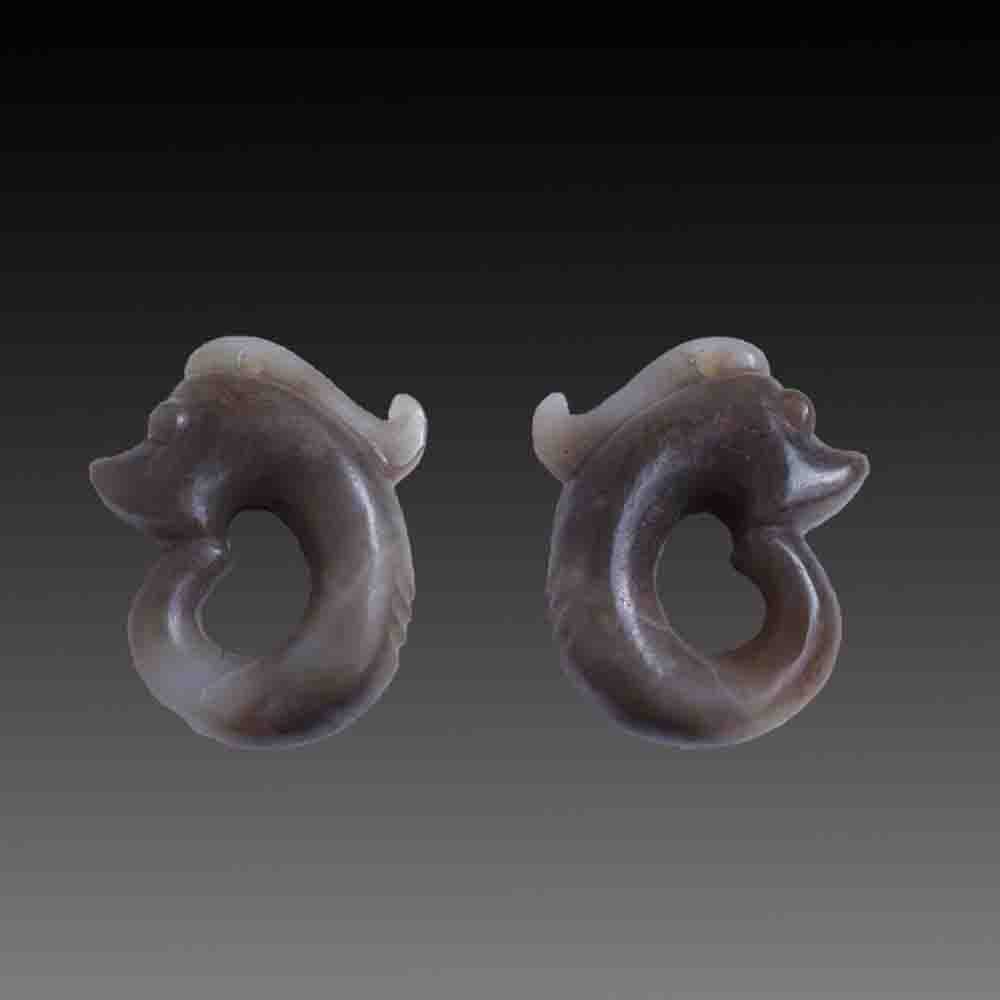“玉猪龙”又称“玉兽形”。学术界为取名曾有争论,有人认为是猪,有人认为是龙,在没有结论的情况下才定名为玉兽形,“玉猪龙”是俗称,还有叫猪母龙的,叫龙胎的,不一而足。有人说它不像猪不像龙却像熊。理由如下:一、红山古玉中有“丫形器”,有人认为是玉兽形的一种变体,其模样是两耳耸立,看上去确实很像熊。猪的耳朵虽大却耷拉下垂的。而熊则形神兼备,耳朵耸立有神韵,不仅会站立而且会行走。与器形相比较,熊直立时似“丫形器”,蹲下时似玉兽形。二、红山文化地域博大,除东北地区外,还包含内蒙古。特别是在东北地区,历史上确有熊崇拜的风俗。鄂温克族萨满教是原始宗教的一种晚期形式,把图腾上的熊尊为祖先熊,为该教的守护神。此外,在祭礼仪式中,还有隆重的祭熊和风葬仪式。鄂伦春族也是一个熊崇拜的民族,他们称公熊为“合克”(祖父),称母熊为“恶我”(祖母),猎熊时假托别人所为,把杀死熊的刀说成没有刃口的钝刀,把熊的死说成睡觉,吃熊肉时学乌鸦叫,送葬时还需哭泣致哀,并再三祷告熊的保佑。三、在东北地区民间传说中,有许多与熊崇拜相关的故事。如一母熊将幼熊一撕为二,一爿依然是熊,另一爿则成为鄂伦春人的祖先。又如,一猎人打杀了一只熊,后来居然发现是失踪多年的妻子,以证熊就是人的化身。

萨满教文化在树立自己精神力量的过程中,曾在诸多对自己有恩惠的和凶恶、强大的森林动物中选择,大家不约而同地逐渐向熊靠拢。例如牛河梁积石冢中多次出土熊的下颌骨,女神庙遗址还出土有泥塑的熊下颌,而且位于主室中心位置,可能具有动物神中主神的地位。
有学者认为红山文化出土的玉猪龙短立耳、圆睛的特征与熊相似,应称之为熊龙。红山萨满将熊龙玉雕系挂在衣服上,是借着熊神果敢、勇猛、神力无敌的特性,增加自己的法力。
玉猪龙是红山文化玉器的典型代表。玉器也采用线切割和片切割的方式,常见的线切割多表现在玦口和玉箍形器内孔上。一般简单常见的有透雕、宽槽、粗阴线、打洼等工艺,线拉工较少,纹饰一般用玛瑙或石英工具加水和解玉砂磨制而成。钻孔使用桯钻和管钻。一般有单面钻、双面对钻和倾斜对钻三种表现形式方式。由于加工工具原始,转速较慢,所以在钻孔的过程中就完成了打磨,所有孔道上都可看见不规则的螺旋痕迹,包浆自然。玉器的打磨、抛光十分讲究,多呈蜡状光泽。
该猪龙通体抛光,浑厚圆滑、线条流畅、造型生动,是红山文化同类玉器中形体和形制最规则的一件。C形玉龙用整块墨绿色软玉雕刻而成,体蜷曲呈“C”字形,昂首扬颈、弯背卷尾、吻部前伸、鼻端截平、梭眼上翘、头似猪首、颈鬣上卷。
"Jade pig dragon" is also called "jade animal shape". Some people think it is a pig, while others think it is a dragon. In the absence of any conclusion, it was named Yuzhuxing. "Yuzhulong" is a common name, and some are called "pig mother dragon" and "dragon fetus". Some people say it's not like a pig, it's not like a dragon, it's like a bear. The reasons are as follows: First, there is "wenshaped device" in Hongshan ancient jade, some people think it is a variant of jade animal shape, its appearance is two ears stand up, it looks really like a bear. The pig's ears are big but droopy. Bears, on the other hand, are both physically and mentally capable of walking as well as standing up. Compared with the shape of the vessel, the bear looks like a "wench-shaped vessel" when upright and a jade beast when squatting down. Second, the Hongshan culture area is broad, in addition to the northeast region, also includes Inner Mongolia. Especially in the northeast region, there is a custom of bear worship in history. Ewenki Shamanism is a late form of primitive religion, in which the bear on the totem is revered as the ancestor bear and the patron saint of the religion. In addition, in the ceremony, there are grand bear sacrifice and wind burial ceremony. Olunchun is also a people bear worship, they called male bears close "g" (grandfather), called a bear "bad me" (grandmother), bear hunting's when the other people, to kill the bear knife as no edge blunt knife, as the death of the bear to sleep, eat bear meat caw, mourners also need to cry, marking and repeatedly prayer bear bless. 3. In the folklore of Northeast China, there are many stories related to bear worship. For example, when a mother bear tears a baby bear into two parts, one part is still a bear, and the other part becomes the ancestor of Oroqen people. Another example is a hunter who killed a bear and later found out that it was his wife, who had been missing for years, to prove that the bear was the incarnation of a man.
In the process of building up their spiritual strength, Shamanism culture used to choose among many forest animals that were kind to them and ferocious and powerful, and all of them gradually drew closer to bears. For example, the bear's mandible was unearthed many times in the stone mound of Niuheliang, and the clay sculpture of the bear's mandible was also unearthed in the site of Nu Temple, which is located in the center of the main chamber, and may have the status of the main god among animal gods. [8]
Some scholars believe that the characteristics of Yuzhu dragon unearthed from Hongshan Culture are similar to those of bears with short erect ears and round eyes, so it should be called Xiong Long. The Hongshan Shaman hangs the jade carving of the bear dragon on his clothes to increase his magic power by virtue of the character of the bear god, which is courageous, brave and invincible.
Jade pig dragon is a typical representative of Hongshan culture jade. Wire cutting and piece cutting are also used in jade articles. The common wire cutting is mostly found in the openings of the jue mouth and the inner holes of the jade hoop shaped articles. Generally simple and common are the process of penetrating carving, wide groove, coarse Yin line, playing wa, etc., with less line drawing, and the grain is generally made of agate or quartz tools, water and jade sand. The upper end of the drill and the pipe drill are used to drill holes. Generally, there are three forms of expression: single side drilling, double face drilling and inclined to drilling. Because the processing tools are original and the rotation speed is slow, the grinding is completed in the process of drilling. Irregular spiral traces can be seen on all the holes, and the coating is natural. The polishing and polishing of jade wares are very exquisite, and they are mostly waxy and shiny.
The whole body of the pig and dragon is polished, smooth, smooth, and vivid in shape. It is the most regular in shape and shape among the similar jade wares of Hongshan culture. C-shaped Jade Dragon is carved from a whole piece of dark green neflite. Its body is curled in the shape of "C", with its head held high and neck held high, its back curved and tail curled, its snout extended forward, its nose cut flat, its shuttles upturned, its head resembling a pig's head and its neck curled up.


